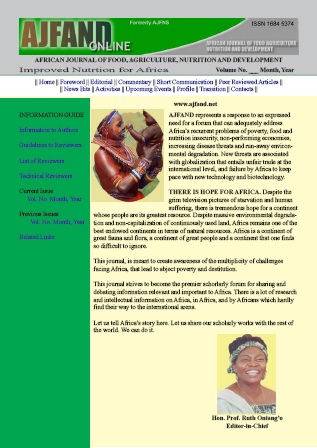
|
African Journal of Food, Agriculture, Nutrition and Development
Rural Outreach Program
ISSN: 1684-5358
EISSN: 1684-5358
Vol. 14, No. 2, 2014, pp. 8736-8747
|
 Bioline Code: nd14022
Bioline Code: nd14022
Full paper language: English
Document type: Research Article
Document available free of charge
|
|
|
African Journal of Food, Agriculture, Nutrition and Development, Vol. 14, No. 2, 2014, pp. 8736-8747
| en |
ACCEPTABILITY OF CHICKEN POWDER IN HOME PREPARED COMPLEMENTARY FOODS FOR CHILDREN IN GHANA
Anderson, A.K.; Bediako-Amoa, B. & Steiner-Asiedu, M.
Abstract
The persistent problem of childhood malnutrition and growth faltering in sub-Saharan African countries such as Ghana despite food aid intervention programs, suggests rethinking of the content and mode of delivery of such food programs. While several food programs and formulations exist for the treatment and management of childhood malnutrition, most are neither culturally appropriate nor easily accessible to families at the household level. There is, therefore, a need for a food product that can be tailored to a particular culture and local food produce which provides the necessary macronutrients and micronutrients in adequate amount and is easy to use at the household level to prevent malnutrition. The aim of this study was to evaluate the acceptability of incorporating chicken powder into the Ghanaian child’s everyday meal. Participants in the study included mothers and their pre-school age children. The chicken powder was incorporated into a breakfast meal (“Tom Brown”) and lunch/supper meal (rice and gravy) on weight basis according to predetermined proportions of the raw ingredients. Each meal consisted of a control sample (not containing chicken powder) and 3 test samples containing different amounts of chicken powder (15%, 20% and 25% by weight). Overall, both mothers and children rated both control samples highest compared to their respective test sample for preference. Interestingly, mothers were able to tell the differences in the test samples, but the children could not tell the difference between the test samples by the content of the chicken powder according to the results of the test for homogeneity. The results from the acceptability test as well as individual observation by the research team suggest that chicken powder can be used as animal source protein in the treatment and management of malnutrition by incorporating it into common staple foods. According to findings of this study, parents are more likely to incorporate the chicken powder (an animal source quality protein) in their children’s diet, if not for the entire family. The incorporation of chicken powder into complementary foods will improve the nutritional value, especially the protein and micronutrient content.
Keywords
Chicken; Acceptability; Ghana; Malnutrition; Feeding
|
| |
© Copyright 2014 - African Journal of Food, Agriculture, Nutrition and Development
Alternative site location: http://www.ajfand.net/
|
|
